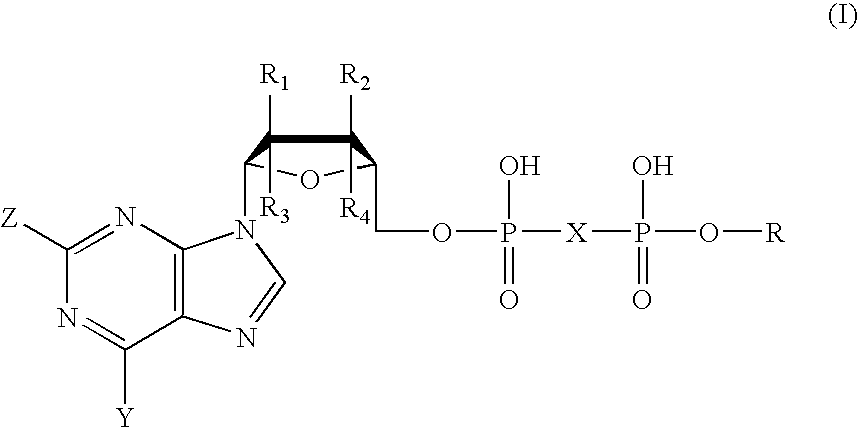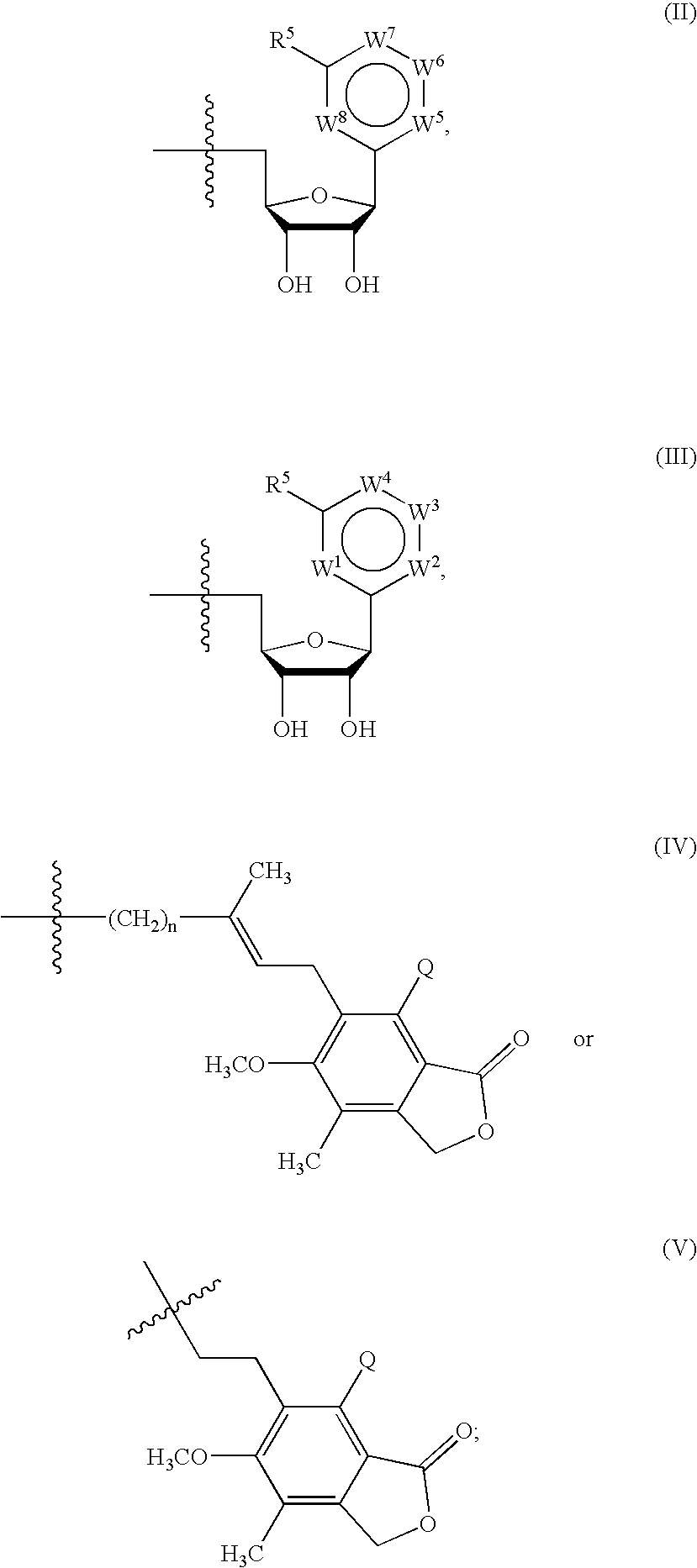Antiviral agents for treatment of Flaviviridae infections
a technology for antiviral agents and flaviviridae, which is applied in the direction of group 5/15 element organic compounds, drug compositions, immunological disorders, etc., can solve the problems of unfavorable pharmacokinetics, lack of enzyme specificity, and unfavorable activity profiles of mmf, so as to prevent the occurrence of clinical symptoms, and reduce the toxicity of host cells.
- Summary
- Abstract
- Description
- Claims
- Application Information
AI Technical Summary
Benefits of technology
Problems solved by technology
Method used
Image
Examples
example 1
5-(2,4;3,5-Di-O-benzylidene-D-hexityl)-3-bromopyridine (13 and 14, R.dbd.H, R.sup.5.dbd.Br, W.sub.6.dbd.N, W.sub.5.dbd.W.sub.7.dbd.W.sub.8.d-bd.CH)
[0242] To a solution of 3,5-dibromopyridine (1.45 g, 6.12 mmol) in dry ethyl ether (50 mL) is slowly added (ca. 10 min) a solution of n-butyllithium (2.35 mL, 2.6 M solution in n-hexane, 6.12 mmol) below -50.degree. C. under argon atmosphere. After addition is completed, the reaction mixture is further stirred for 15 minutes. The mixture is then cooled to -78.degree. C. and a solution of 2,4;3,5-di-O-benzylidene-D-ald-ehydo-ribose (12, 500 mg, 1.53 mmol) in tetrahydrofuran (5 mL) is added dropwise, and then the reaction mixture is allowed to warm to room temperature. Water (50 mL) is added to the reaction mixture. The organic layer is separated, washed with brine (30 mL.times.3), dried over sodium sulfate, and then concentrated in vacuo. The residue is chromatographed on a column of silica gel (20 g) using first methylene chloride and the...
example 2
Methyl 5-(2,4;3,5-di-O-benzylidene-D-hexityl)nicotinate (13 and 14, R.dbd.H,R.sup.5.dbd.CO.sub.2CH.sub.3, W.sub.6.dbd.N, W.sub.5.dbd.W.sub.7.dbd.W.sub.8.dbd.CH)
[0286] To a solution of 5-(2,4;3,5-di-O-benzylidene-D-hexityl)-3-bromopyri-dine (200 mg, 0.43 mmol) in a mixture of hexamethylphosphoric triamide (0.5 mL) and ethyl ether (5 mL) is added a solution of butyllithium (2 mL of 2.5 M solution in n-hexane, 5 mmol) under argon atmosphere at -78.degree. C. After the addition, the mixture is stirred at -78.degree. C. for 15 minutes. A large excess of solid carbon dioxide is added, and the mixture is allowed to warm to room temperature. The mixture is acidified by addition of 1N hydrochloric acid to pH 4, and the organic layer is washed with brine (3.times.5 mL), dried over sodium sulfate. After removal of sodium sulfate by filtration, the filtrate is cooled to 0.degree. C. and treated with a large excess of ethereal diazomethane. Excess diazomethane is then destroyed by addition of ac...
example 3
Methyl 5-(2,4;3,5-di-O-benzylidene-D-hexityl)nicotinamide (13 and 14, R.dbd.H, R.sup.5.dbd.CONH.sub.2, W.sub.6.dbd.N, W.sub.5.dbd.W.sub.7.dbd.W-.sub.8.dbd.CH)
[0298] An altro / allo epimeric mixture of methyl 5-(2,4;3,5-di-O-benzyliden-e-D-hexityl)-nicotinate (220 mg, 0.48 mmol) is treated with saturated methanolic ammonia containing a catalytic amount of sodium hydride (ca. 2 mg), and the mixture is stirred at room temperature overnight. The solvent is removed in vacuo, and the residue is chromatographed on a silica gel column using chloroform-methanol (95:5) as the eluent. Methyl 5-(2,4;3,5-di-O-benzylidene-D-hexityl)nicotinamide is obtained as a mixture of altro and allo epimers (13 and 14, R.dbd.H, R.sup.5.dbd.CONH.sub.2, W.sub.6.dbd.N,W.sub.5.dbd.W.sub.7.dbd.W.sub.8.dbd-.CH), as a form, 185 mg (87%). .sup.1H NMR (Me.sub.2SO-d.sub.6): .delta. 3.5-4.3 (5H, m, H-2',3',4',5',5"), 5.00 (1H, m, H-1'), 5.64 5.76, 5.77, 5.89 (2H, 4s, benzylidene-CH<), 7.39 (10H, s, phenyl), 7.50, 8.21 (4H...
PUM
| Property | Measurement | Unit |
|---|---|---|
| Molar density | aaaaa | aaaaa |
| Molar density | aaaaa | aaaaa |
| Molar density | aaaaa | aaaaa |
Abstract
Description
Claims
Application Information
 Login to View More
Login to View More - R&D
- Intellectual Property
- Life Sciences
- Materials
- Tech Scout
- Unparalleled Data Quality
- Higher Quality Content
- 60% Fewer Hallucinations
Browse by: Latest US Patents, China's latest patents, Technical Efficacy Thesaurus, Application Domain, Technology Topic, Popular Technical Reports.
© 2025 PatSnap. All rights reserved.Legal|Privacy policy|Modern Slavery Act Transparency Statement|Sitemap|About US| Contact US: help@patsnap.com



